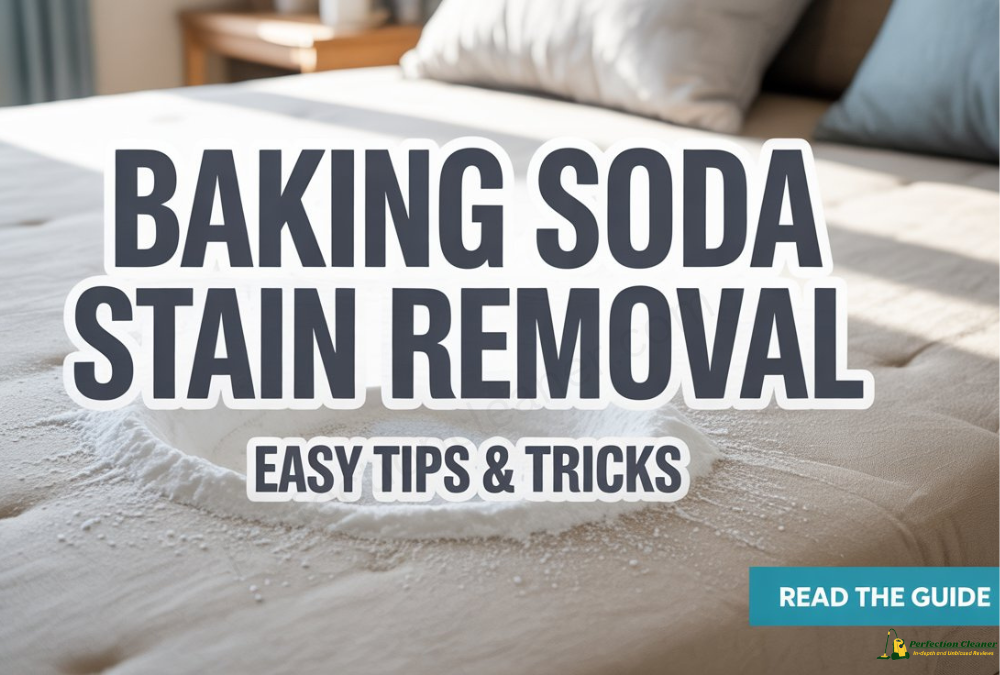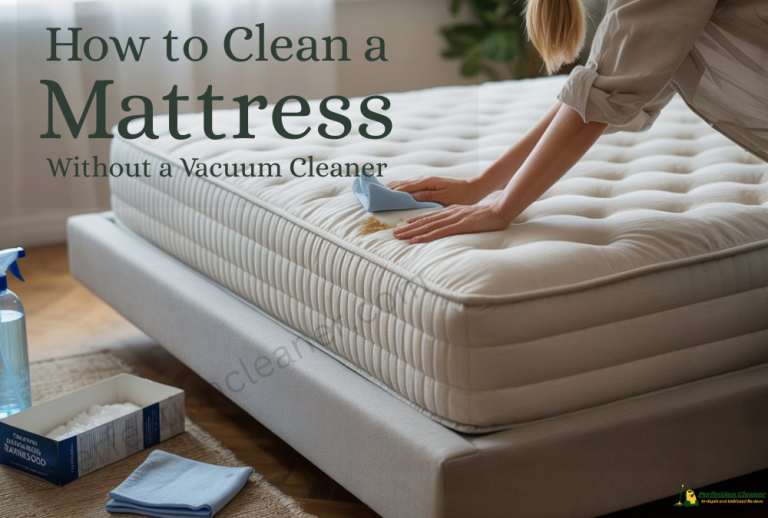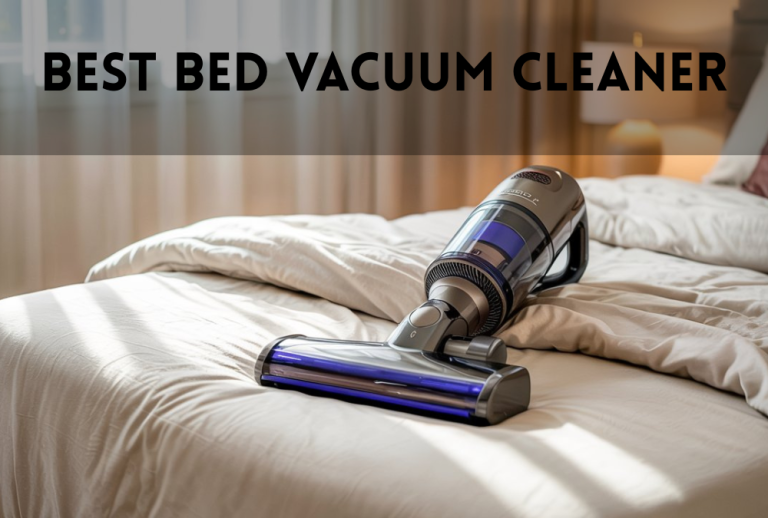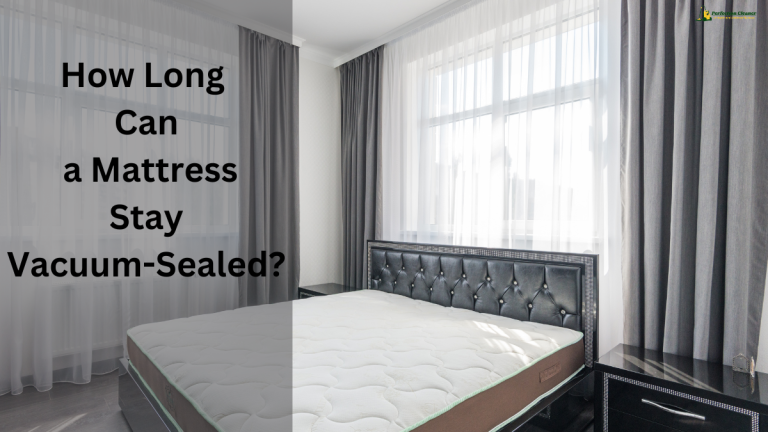How to Remove Baking Soda from Mattress Without Vacuum
Nothing beats a clean, fresh-smelling mattress. That’s why so many people turn to baking soda. It’s cheap, natural, and does a great job of neutralising odours and absorbing moisture. But what happens when you’ve sprinkled it all over your mattress and realise you don’t have a vacuum to clean it up? Panic? Nope. There are several effective ways to remove baking soda from your mattress without a vacuum, and I’m going to walk you through them step-by-step.
This isn’t just about removing some white powder from fabric. Leaving baking soda behind can cause more issues, like dust particles in the air or buildup in your bedding. And if you’re dealing with allergies or respiratory issues, that’s the last thing you need. So whether you live in a dorm, you’re on a tight budget, or your vacuum just broke down, this guide will give you all the practical ways to clean up the mess without needing any high-end equipment.
We’ll cover everything from basic tools you probably already have at home to clever techniques that work surprisingly well. And yes, every step is designed to be simple, affordable, and easy to follow, even if you’re doing this for the first time.
Why Baking Soda is Used on Mattresses
Why use baking soda on a mattress in the first place? It all comes down to its powerful cleaning properties. Baking soda, also known as sodium bicarbonate, is a natural deodoriser. It neutralises smells without covering them up, making it perfect for things like body odour, spilt drinks, or even pet smells.
But that’s not all. Baking soda also helps absorb moisture. If you sweat at night or have minor spills, sprinkling some on your mattress can help soak it up and reduce the chance of mould or mildew forming. It’s gentle on fabric, safe for the skin, and doesn’t come with that chemical smell that many commercial cleaners have.
People usually apply baking soda by sprinkling it generously across the surface of the mattress, letting it sit for several hours (or even overnight), and then vacuuming it off. But without a vacuum? That’s where things get tricky. Unlike larger particles, baking soda is very fine; it can cling to fibres and become difficult to remove with simple wiping. That’s why this guide is so important. We’ll teach you how to work around that.
Challenges of Removing Baking Soda Without a Vacuum
Here’s the thing: baking soda seems harmless, but when it comes time to clean it off, especially without a vacuum, it can be stubborn. Why? Because of its texture. Baking soda is a very fine powder, it’s similar to flour or powdered sugar in consistency. Once it settles into the mattress fabric, it doesn’t just sit on the surface. It weaves its way in, clinging to the fabric and padding like glitter on a carpet.
If you try to wipe it with a dry cloth, you might push it deeper. Use too much water, and it turns into a paste, which makes it even harder to clean. It’s a bit like trying to get sand out of a shaggy carpet using only your hands, frustrating and messy.
Also, without a vacuum, you risk leaving behind some of the powder. This might not seem like a big deal, but over time, it can attract dust or cause irritation, especially for those with allergies or asthma. Plus, if the mattress isn’t dried properly after using any liquid-based method, you could end up dealing with mildew, yuck.
But don’t worry. The techniques we’ll discuss use smart, simple tools to overcome these challenges. No special equipment is needed, just everyday items used the right way.
Tools and Materials You’ll Need
Before we dive into the cleaning methods, let’s do a quick inventory check. Don’t worry, most of these are things you likely already have lying around your home. Here’s what you’ll need, depending on the method you choose:
- Soft-bristle brush or hand broom – For gently sweeping a cup of baking soda
- Dustpan – To collect and remove the powder
- Microfiber or cotton cloths – For blotting or wiping
- Water spray bottle – For dampening without soaking
- Lint roller or wide tape – Great for picking up surface-level powder
- Hairdryer or portable fan – For drying and dislodging fine particles
- White vinegar (optional) – For neutralising any remaining odours
- Essential oils (optional) – For a fresher scent
- Mattress protector (for next time) – To prevent future issues
Each method in the next section will highlight which tools you’ll need, so don’t worry about using them all at once. The goal is to give you multiple solutions so you can pick the one that works best for your situation.
Step-by-Step Methods to Remove Baking Soda Without a Vacuum
Method 1: Using a Brush and Dustpan
This is the most straightforward method, and it’s surprisingly effective when done right. Grab a soft-bristle brush, like a hand broom, baby brush, or even a clean paintbrush. You want something that won’t damage the fabric but has enough firmness to move the powder around.
Here’s what to do:
- Start from one corner of the mattress and work across in straight lines.
- Gently sweep the baking soda into a small pile.
- Once you’ve gathered enough, scoop it up with the dustpan.
- Repeat this process until most of the powder is removed.
The key is to be gentle. If you scrub too hard, you’ll push the powder deeper into the mattress. It’s best to go slow and keep your movements controlled. You may not get every speck, but you’ll lift a good amount of it off the surface.
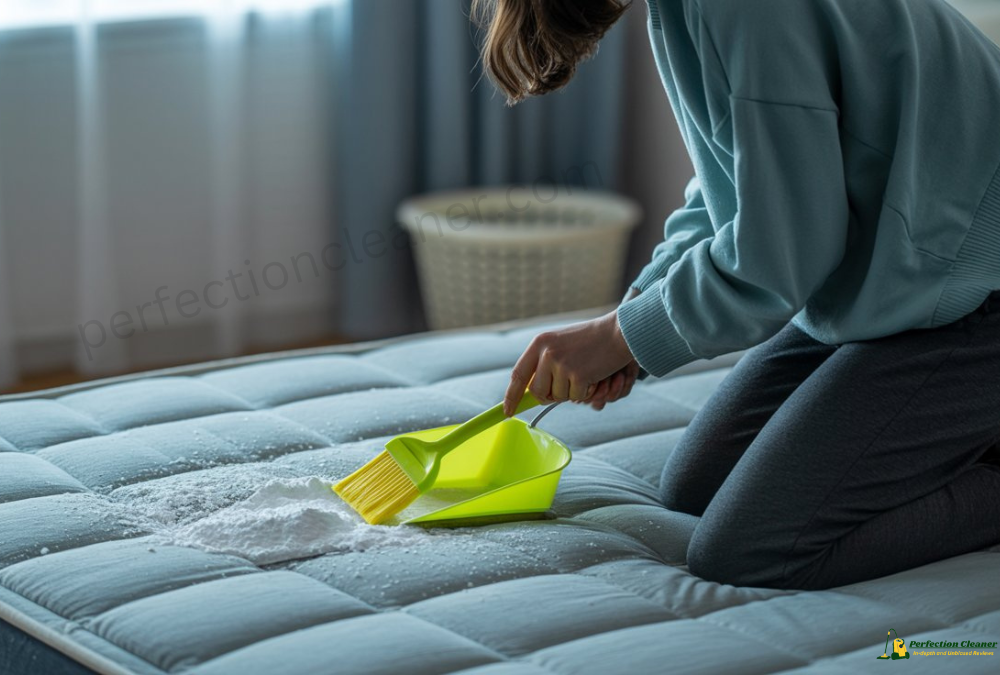
Method 2: Damp Cloth Technique
This method works well if the baking soda has settled deep into the fabric, and brushing doesn’t quite cut it. The damp cloth technique allows you to pick up particles without pushing them further into the mattress, just be careful with how much moisture you use.
Here’s how to do it:
- Lightly dampen a clean microfiber or cotton cloth with water. It should be just moist, not dripping wet.
- Press the cloth gently onto the baking soda-covered area. Don’t rub, just blot.
- The dampness helps lift the powder without embedding it further.
- After each blot, fold the cloth to a clean section and repeat.
- If needed, rinse the cloth and start again until you’ve removed as much as possible.
What makes this method effective is moisture control. If your cloth is too wet, it’ll turn the baking soda into a paste-like mess that will dry into a crust. If it’s too dry, it won’t pick up much. Keep a spray bottle handy so you can fine-tune the dampness.
Afterwards, leave the mattress to air dry completely, either with open windows or a fan directed at it. You don’t want any residual dampness turning into mildew. If you’re in a humid area, using a blow dryer in a cool setting can speed things up.
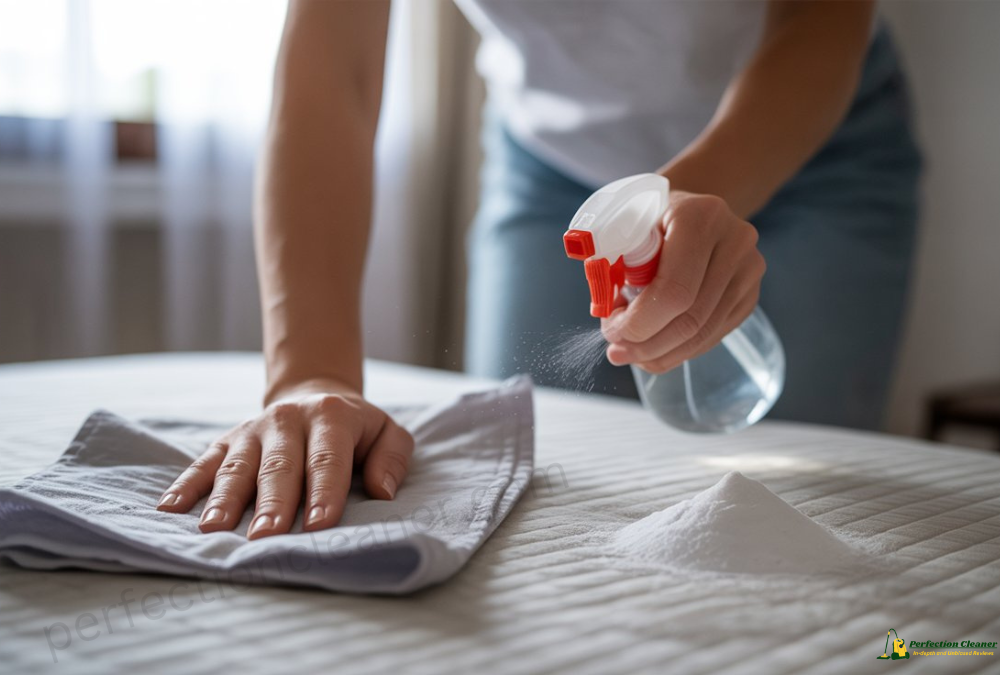
Method 3: Lint Roller or Tape Method
Got a lint roller lying around? Perfect. This is one of the most underrated tools for picking up baking soda from the surface of your mattress. It’s especially useful for those finer particles that seem to evade both sweeping and blotting.
What to do:
- Roll the lint roller across the baking soda-covered area.
- Apply gentle pressure to make sure the adhesive picks up the powder.
- Replace the sticky sheet as soon as it loses its grip.
- Continue until you’ve covered the entire mattress.
If you don’t have a lint roller, don’t worry, duct tape or packaging tape works just as well. Just wrap it around your hand with the sticky side out and pat the surface like you’re trying to pick up pet hair. You’ll be surprised how much you collect this way.
This method is great for touch-ups after brushing or blotting. It’s not the fastest if you’re dealing with a lot of powder, but it’s fantastic for fine cleanup. Just be gentle so you don’t damage the mattress fabric or leave sticky residue behind.
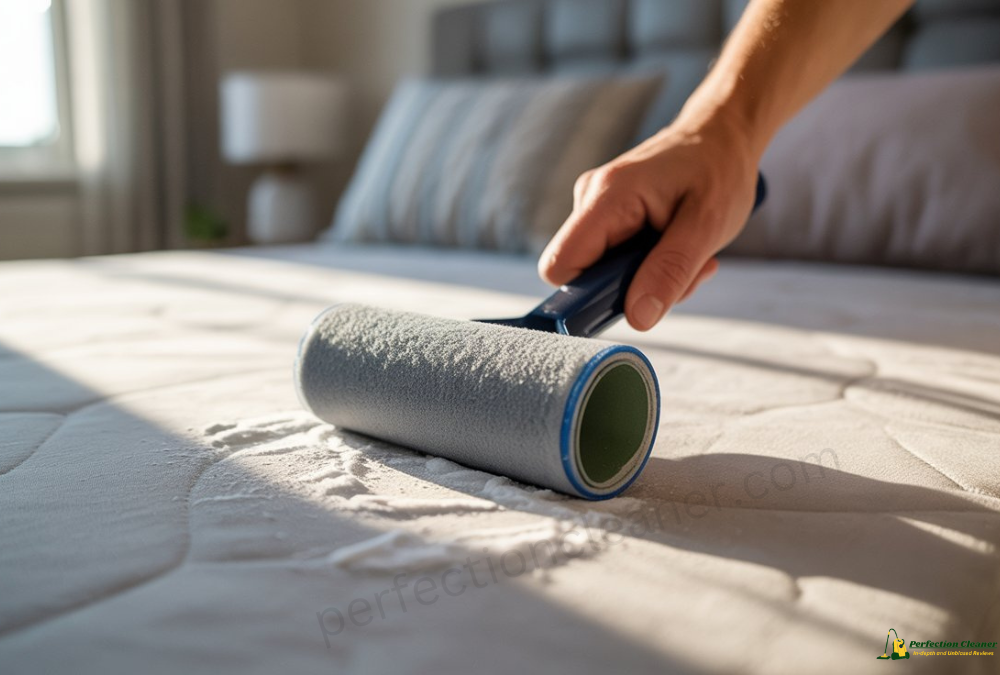
Method 4: Blow Dryer or Fan Approach
When you’re really in a bind and don’t want to manually sweep, blot, or dab, turn to airflow. The idea here is to use a steady stream of air to lift and move the baking soda particles off the surface of your mattress.
How to make it work:
- Use a hairdryer in a cool or warm (not hot) setting.
- Hold it several inches above the mattress and slowly move it across the surface.
- Blow the powder off the edge or into a corner where it can be collected with a cloth or dustpan.
- Alternatively, place a fan near the mattress and use a brush to gently agitate the surface so the powder lifts and blows away.
This method works best in well-ventilated spaces or when used in combination with other techniques. It’s not a one-and-done method, but it can help loosen stuck particles and make the other methods more effective.
One pro tip: Do this in a room where the floor is easy to clean. You don’t want to blow baking soda off the mattress just to have it settle in your carpet.
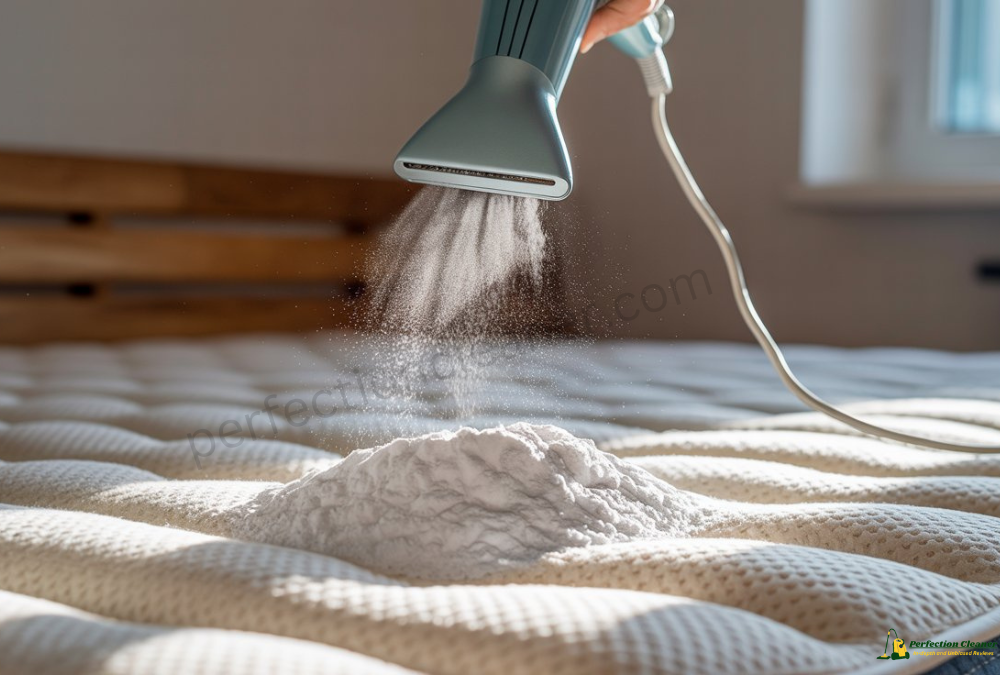
Pros and Cons of Removing Baking Soda Without a Vacuum
Pros
1. No Special Equipment Needed
You don’t need to own or buy an expensive vacuum cleaner. Most methods use everyday household items like brushes, cloths, or tape.
2. Cost-Effective
Since you’re using basic supplies like lint rollers, microfiber cloths, or vinegar, this approach is practically free.
3. Eco-Friendly Methods
Most DIY cleaning methods use natural ingredients like vinegar, baking soda, and essential oils, which are safer for the environment and your health.
4. Quiet and Convenient
No loud vacuum noise, perfect for shared living spaces, late-night cleaning, or dorm rooms.
5. Great for Small Messes
If the amount of baking soda is minimal or isolated to one area, manual removal can be just as effective as vacuuming.
Cons
1. Time-Consuming
Manual methods require significantly more time and effort. Brushing, blotting, and drying each take time to do properly.
2. Less Effective for Deep Cleaning
Without a vacuum’s suction, it’s harder to remove baking soda that has settled deep into the mattress fibres.
3. Risk of Residue
Fine particles can cling to fabric, and without suction, you may not be able to remove all the residue. This could cause irritation or dust buildup over time.
4. Moisture Risks
Using damp cloths or vinegar solutions can lead to moisture seeping into the mattress if not dried thoroughly, increasing the risk of mildew or mould.
5. Repetitive Process
You may need to go over the same area multiple times with different methods (brush, cloth, tape) to fully remove the baking soda.
Cleaning Residue and Freshening Up
Once you’ve removed most of the baking soda, there’s a good chance there’s still a light residue left behind. This doesn’t just look odd, it can also feel gritty under the sheets or contribute to dust buildup.
Vinegar and Water Solution
Vinegar is a natural cleaner and deodorizer that works wonders on baking soda residue. When it comes into contact with baking soda, it reacts to form carbon dioxide and water, lifting the powder out of the fabric and making it easier to wipe away.
What to do:
- Mix a solution of equal parts white vinegar and water in a spray bottle.
- Lightly mist the mattress (don’t soak it!).
- Allow it to fizz and sit for 5–10 minutes.
- Blot with a clean, damp cloth.
- Dry with a fan or hairdryer.
The vinegar smell won’t last long. It evaporates quickly and leaves the mattress smelling neutral. If you’re not a fan of the scent, keep reading.

Essential Oils and Freshening Sprays
Want to leave your mattress smelling like lavender fields or a citrus grove? A few drops of essential oil can make a big difference in the overall freshness.
DIY Freshening Spray:
- 1 cup of distilled water
- 10 drops of your favourite essential oil (like lavender, tea tree, or eucalyptus)
- Optional: a tablespoon of vodka or rubbing alcohol (helps the scent last longer)
Spray a light mist over the mattress after cleaning and let it air dry. Not only does this help kill any leftover bacteria, but it also gives your bed that “just-washed” scent we all love.
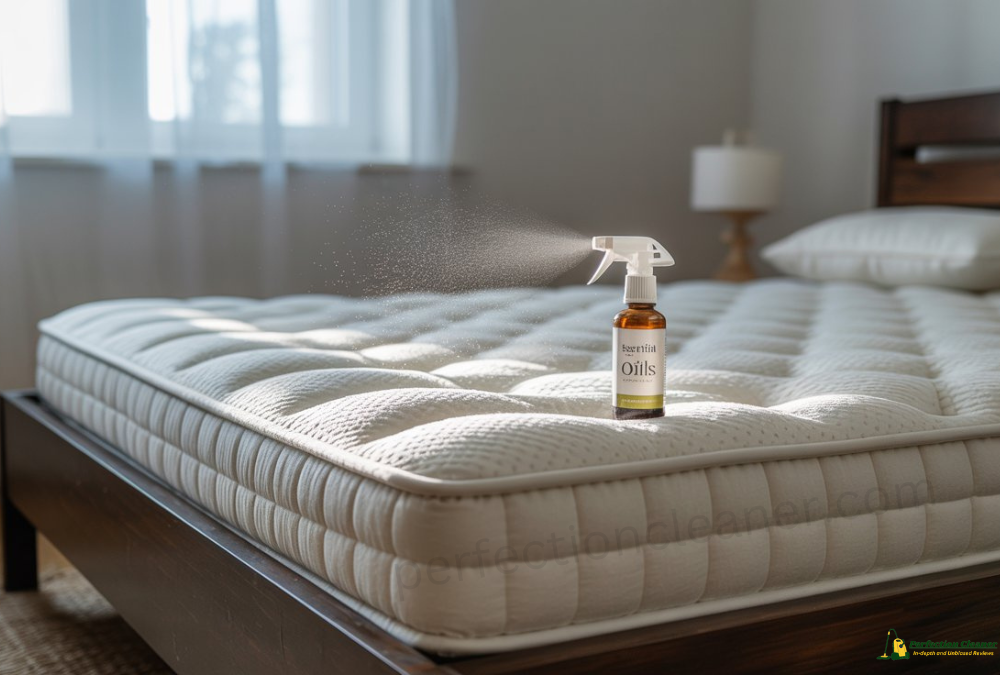
Drying Your Mattress Completely
Now that you’ve cleaned everything, your job isn’t quite done. One of the most important steps often overlooked is drying your mattress completely. Any moisture left behind can seep into the layers and lead to mildew, mould, or unpleasant odours.
Tips for drying:
- Set up a fan close to the mattress and let it run for a few hours.
- If the weather permits, place the mattress near an open window for natural air drying.
- Use a hairdryer on the cool setting for quicker results in smaller spots.
- Flip the mattress (if it’s double-sided) and repeat the drying process.
Check for damp spots by pressing a dry towel on the surface. If it comes away even slightly moist, keep drying. Better safe than sorry.
Preventing Future Messes
Now that your mattress is clean and fresh again, let’s talk prevention. Because let’s face it, while baking soda is a handy solution, having to remove it without a vacuum is a hassle. So, how do you keep your mattress clean without needing to go through this whole ordeal again?
1. Use a Mattress Protector
This is one of the best investments you can make. A quality mattress protector is waterproof, washable, and acts as a shield against spills, dust, sweat, and allergens. They’re easy to remove and toss in the washing machine, which makes maintaining a fresh bed way easier.
2. Spot Clean Immediately
Accidents happen. Whether it’s a coffee spill or your dog tracked in dirt, the sooner you handle it, the less likely you’ll need deep-cleaning solutions like baking soda. Use a mild detergent and water or a fabric-safe disinfectant to dab the area clean before it sets in.
3. Air It Out Regularly
Let your mattress breathe! Every time you change your sheets, give it a few hours to air out. If possible, place it near an open window or use a fan to keep things ventilated. This prevents moisture buildup and minimises odours.
4. Limit Eating or Drinking in Bed
This one’s tough for binge-watchers and breakfast-in-bed lovers, but it’s a game changer. Crumbs, spills, and sticky spots are the main reasons people reach for baking soda in the first place. Cutting back on food in bed can cut down on future messes.
5. Rotate and Flip the Mattress
To prevent uneven wear, rotate your mattress head-to-foot every few months. If it’s double-sided, flip it over once or twice a year. This not only helps with longevity but can also prevent certain areas from becoming hotspots for odours or moisture.
When to Consider Professional Cleaning
Sometimes, no matter how many DIY tricks you try, your mattress still seems… off. Maybe the odour lingers, or there’s a suspicious yellow stain that won’t go away. In those cases, it might be time to call in the pros.
Here’s when professional cleaning makes sense:
- Deep or long-term stains: If you’ve got stains from sweat, urine, or food that have been there for months (or longer), pros have the tools and solutions to handle them.
- Persistent odours: When nothing seems to eliminate that musty or funky smell, it could be bacteria or mould deeper in the mattress.
- Dust mites and allergens: If you suffer from allergies or asthma, a deep steam clean can kill dust mites and remove allergens better than surface-level cleaning.
- Water damage or mould risk: If your mattress ever gets seriously wet and isn’t dried quickly, mould may grow inside. That’s not something you want to DIY.
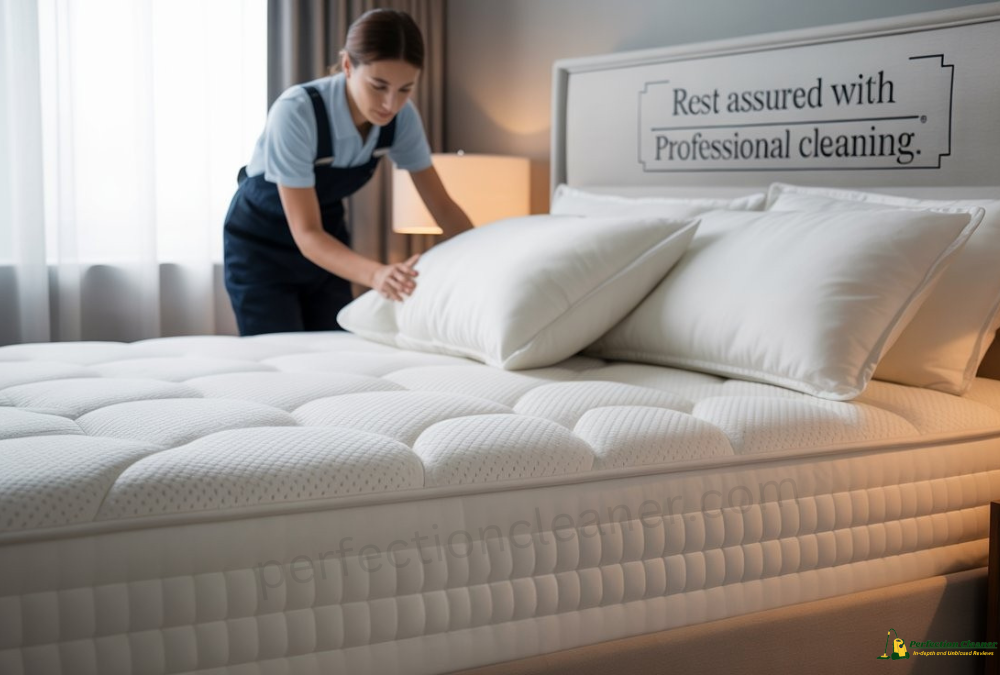
Professional mattress cleaning services often use high-grade steamers, eco-friendly solutions, and equipment that penetrates deep into the material, something that’s hard to replicate at home. The cost may range from $50 to $150, depending on the size of the mattress and your location, but it’s often worth it for peace of mind.
Conclusion
Cleaning up baking soda from a mattress without a vacuum might sound like a daunting task, but as you’ve seen, it’s entirely doable with the right methods and a bit of patience. Whether you’re using a soft brush and dustpan, blotting with a damp cloth, rolling up powder with tape, or using airflow to your advantage, there’s always a way to get the job done.
Once you’ve cleared the powder, take it a step further with a vinegar rinse or essential oil spray to refresh and deodorise. And don’t forget, proper drying is key to preventing mould and musty smells.
Most importantly, a little prevention goes a long way. Investing in a mattress protector, being mindful of spills, and airing things out regularly will save you from future deep cleans and make your mattress feel brand new for years.
Keep your sleep sanctuary fresh, and remember, your bed should be a place of rest, not stress.
FAQs
1. Can I use a hairdryer to remove baking soda from my mattress?
Yes! A hairdryer on a cool or warm (never hot) setting can help blow fine baking soda particles off the surface. Use it in combination with a brush or cloth for the best results.
2. What’s the best natural solution to clean a mattress without a vacuum?
A combination of baking soda, vinegar, and essential oils works wonders. Use baking soda to deodorise, vinegar to neutralise, and oils to refresh the scent.
3. Is it safe to sleep on a mattress with baking soda residue?
It’s not dangerous, but it may irritate people with allergies or sensitive skin. Plus, it can feel gritty and uncomfortable. Always remove as much as possible before remaking the bed.
4. How long does it take for a mattress to dry after cleaning?
Drying can take anywhere from 2 to 6 hours, depending on how much moisture was used and the room’s ventilation. Always ensure it’s completely dry before putting on sheets.
5. Can I use a wet/dry mop instead of a vacuum?
In some cases, yes, but be cautious. A mop could push the baking soda deeper into the fabric. If using one, go very lightly and follow up with blotting and drying.
Find More about Mattresses and Vacuums:
How to Clean a Mattress Without a Vacuum Cleaner, Best Bed Vacuums, How to Store a Mattress?, How Long Do You Leave a Vacuum-Packed Mattress?, Best Vacuum Cleaner for Mattresses, How to Dispose of a Vacuum Cleaner, Are Refurbished Shark Vacuums Worth It?

